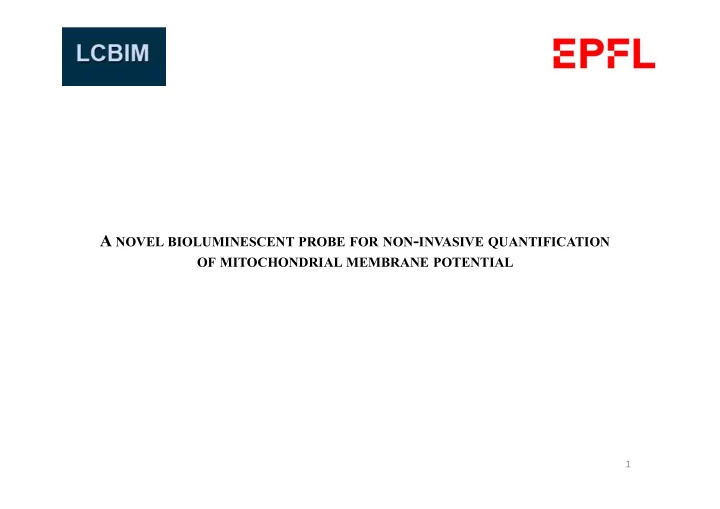

A NOVEL BIOLUMINESCENT PROBE FOR NON - INVASIVE QUANTIFICATION OF MITOCHONDRIAL MEMBRANE POTENTIAL 1
Main function of mitochondria is ATP synthesis Electrochemical proton gradient is the driving force for ATP synthesis 2
Electron transport chain (ETC) Energy of proton gradient: � ∆𝐻 = �𝐺∆𝜔 � RT ln 𝐼 �� � 𝐼 ��� = �𝐺∆𝜔 � 2.3RT Δ𝑞𝐼 Δψ – electric potential, MMP 3 Nicholls, D. G. & Ferguson, S. J. Bioenergetics . Fourth edition / edn, (Academic Press, Elsevier, 2013).
ATP synthesis is not the only role of mitochondria in a cell Intracellular signaling • Change of gene expression profile • Adaptation to stress • Apoptosis Biosynthetic function • Long chain fatty acids • Branched chain amino acids • Nucleotide biosynthesis Figures are adapted from Cell Metabolism (2015) 22, 204-206 4 Mol. Cell Bio. (2005) 6, 318-327
Mitochondrial dysfunction is involved in many processes MMP dysregulation is implicated in : • Aging • Alzheimer disease • Parkinson’s disease • Diabetes mellitus 2 type • Cardiomyopathy • Ischemia Monitoring of mitochondria function is important to understand progression of these pathologies Mitochondrial membrane potential (MMP) is one of the key parameters that characterizes function of mitochondria 5 Figure is adapted from Cell (2013) 153, 1194-1217
Quantification of MMP relies on fluorescent dyes Decrease of MMP will O lead to decrease of TMRM O fluorescent signal. N O N Intensity of the signal is 30-60 mV proportional to the amount of TMRM that was accumulated O O TMRM Cytosol N O N ∆𝜔 = 𝑆𝑈 𝑨𝐺 ln 𝑈𝑁𝑆𝑁 �� 𝑈𝑁𝑆𝑁 ��� 180-200 mV Mitochondrion Accumulation 6
Drawbacks of fluorescent dyes for measuring MMP • None of them are suitable to be used in living animals (mammals) 7 Methods, ( 2008 ), 46 , 304-311
Measurement of MMP in vivo is extremely important Impossible to create relevant disease model in cell culture • Aging • Alzheimer disease • Parkinson’s disease • Diabetes mellitus 2 type • Cardiomyopathy • Ischemia 8
Strategy for non-invasive imaging of mitochondrial membrane potential (MMP) Bioluminescent imaging + MMP Bio-orthogonal reaction in a context of various diseases 9
The Staudinger reaction + N 3 R' PPh 2 N P R' Ph Azide Phosphine N 2 Ph Aza-ylide H 2 O Hermann Staudinger + PPh 2 NH 2 R' O Amine Phosphine oxide Staudinger, H.; Meyer, J. Helv. Chim. Acta 1919 , 2 , 635.
The Staudinger ligation – the first bioorthogonal reaction Science ( 2000 ) 287 , 2007
Using the Staudinger ligation to activate luciferin O O N 2 OCH 3 OCH 3 + N 3 R' P P N R' Ph Ph Ph Ph phosphine CO 2 H Aza-ylide N N R S S O R = H light CH 3 OH R = not H no light O O H 2 O N R' N R' H O P P Ph Ph Ph Ph Ligation product Nat Chem Biol ( 2005 ) 1 , 13
Using TPP cation to deliver reagents to mitochondria TPP P X - MitoQ (CoQ 10 ) In Phase 2 was proved to protect 30-60 mV against liver damage during hepatitis C 3-10 X O Cytosol O 180-200 mV O H Mitochondrion 100-500 X O 6-10 13 M. Murphy, Biochimica et Biophysica Acta, 1777 (2008), 1028-1031 Edward J. Gane, et al. Liver international (2010), 1019-1026
Design of mitochondria-activated luciferin (MAL) probe How to make luciferin uncaging MMP dependent? 1. Take two reagents that release luciferin upon reaction 2. Target them to mitochondria MMP DEPENDENT ACCUMULATION MMP DEPENDENT RATE OF LUCIFERIN RELEASE 14
The bioluminescent signal intensity depends on MMP Potentiation of reaction rate – 10 5 fold Only mitochondrial uncaging is observed 15
Reaction rate enhancement 𝑆 = 𝑈𝑄𝑄 ≈ 𝐵𝑨𝑗𝑒𝑝𝑈𝑄𝑄 = 𝑈𝑄𝑄𝐷𝑀 ���� �∆� ���� ���� = 10 ��.� , 𝑈𝑄𝑄 𝐵𝑨𝑗𝑒𝑝𝑈𝑄𝑄 𝑈𝑄𝑄𝐷𝑀 ���� ���� ���� = 𝑆 � 𝐵𝑨𝑗𝑒𝑝𝑈𝑄𝑄 ���� 𝑈𝑄𝑄𝐷𝑀 ���� 𝜑 ���� = 𝑙 𝐵𝑨𝑗𝑒𝑝𝑈𝑄𝑄 ���� 𝑈𝑄𝑄𝐷𝑀 ���� ��∆� �∆� = 𝑆 � = 10 ��.� = 10 ��.� , 𝜑 ���� 𝑙 𝐵𝑨𝑗𝑒𝑝𝑈𝑄𝑄 ���� 𝑈𝑄𝑄𝐷𝑀 ���� 𝐵𝑨𝑗𝑒𝑝𝑈𝑄𝑄 ���� 𝑈𝑄𝑄𝐷𝑀 ���� 16
The bioluminescent signal intensity depends on MMP Hyperpolarized mitochondria Intact mitochondria Depolarized mitochondria Very high rate of release High rate of luciferin release Low rate of luciferin release Extremely high signal High signal Low signal FCCP, valinomycin Nigericin Valinomycin Nigericin FCCP 17
Detection of valinomycin induced depolarization in cells HT-1080 luc2 cells O O vs N O N Mitochondria activated luciferin (MAL) TMRM With MAL depolarization is detectable down to 0.5 uM 18
Detection of valinomycin induced depolarization in cells HT-1080 luc2 cells O O vs N O N Mitochondria activated luciferin-3 (MAL3) TMRM Total photon flux [p/(cm 2 *sr)] RFU Response of MAL3 assay is more non-linear 19
Detection of hyperpolarization in cells HT-1080 luc2 cells O O vs N O N Mitochondria activated luciferin-3 (MAL3) TMRM 20
Monitoring mitochondrial potential in vivo 21
Recommend
More recommend